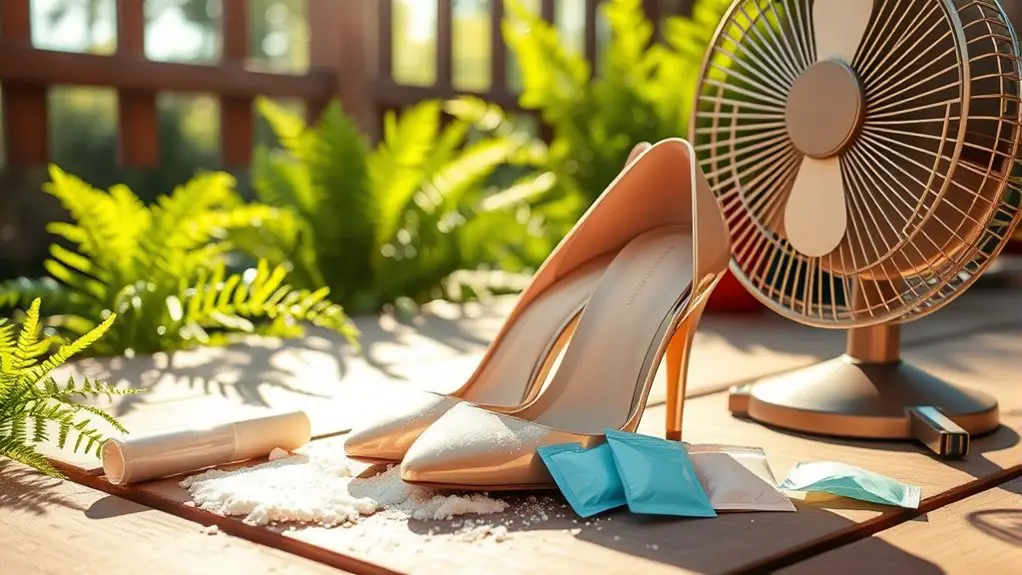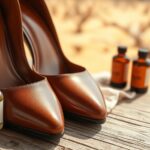To prevent your feet from sweating in heels during summer, choose breathable materials like natural leathers or synthetic mesh for improved airflow. Pair this with moisture-wicking socks made from polyester or merino wool to keep your feet dry. Using foot powder can absorb excess moisture and reduce friction. Rotate your footwear regularly to limit moisture buildup, and maintain foot hygiene by washing and thoroughly drying your feet daily. For more tips on keeping your feet dry in heels, continue on.
Choose Breathable Materials for Your Heels
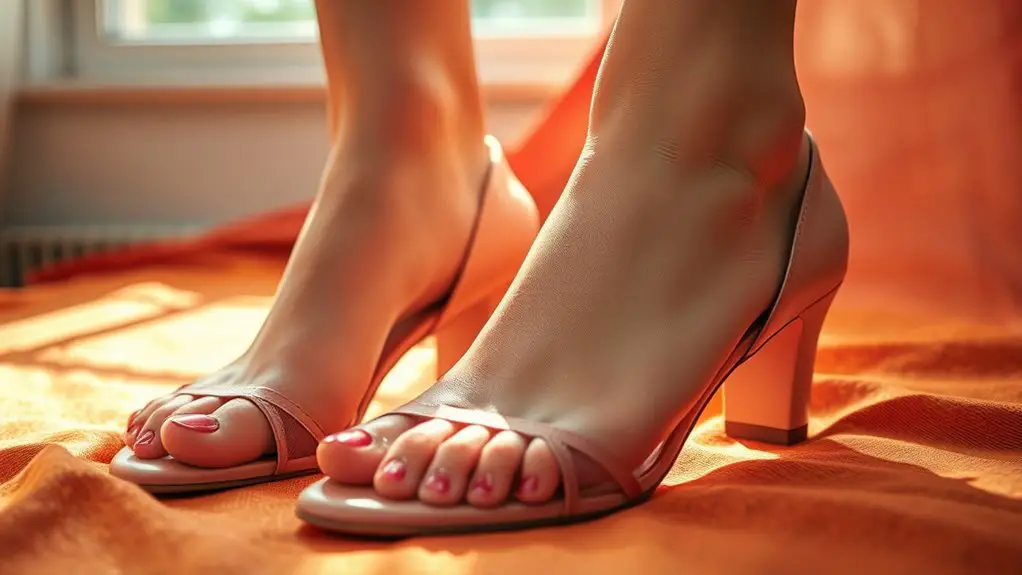
When you’re selecting heels, it’s essential to prioritize breathable materials, as this can greatly reduce the likelihood of sweaty feet. In today’s fashion trends, various material types are available that enhance ventilation. Look for heels made from natural leathers, as they allow moisture to escape while conforming to your foot shape. Suede, while stylish, may trap heat and moisture, so use it wisely.
Additionally, consider synthetic materials designed with breathability in mind, like mesh or perforated fabrics. These materials often feature innovative technology that promotes airflow, making them suitable for warmer climates.
Opt for Moisture-Wicking Socks
Although many overlook the importance of socks when wearing heels, opting for moisture-wicking socks can greatly mitigate foot sweat. These specially designed socks employ advanced materials that enhance moisture absorption, keeping your feet dry and comfortable.
| Sock Material | Benefits |
|---|---|
| Polyester | Excellent moisture-wicking properties, lightweight. |
| Nylon | Durable and quick-drying, helps prevent odor. |
| Merino Wool | Naturally moisture-wicking, temperature-regulating. |
| Bamboo Fiber | Soft, breathable, and antimicrobial properties. |
Choosing the right sock materials is essential. Polyester and nylon are synthetic options that effectively wick moisture away from your skin. In contrast, merino wool and bamboo fiber are natural alternatives that provide comfort and breathability. By integrating moisture-wicking socks into your footwear routine, you can greatly reduce the discomfort caused by sweaty feet while wearing heels, ensuring a more pleasant experience during the hot summer months.
Use Foot Powder for Extra Dryness
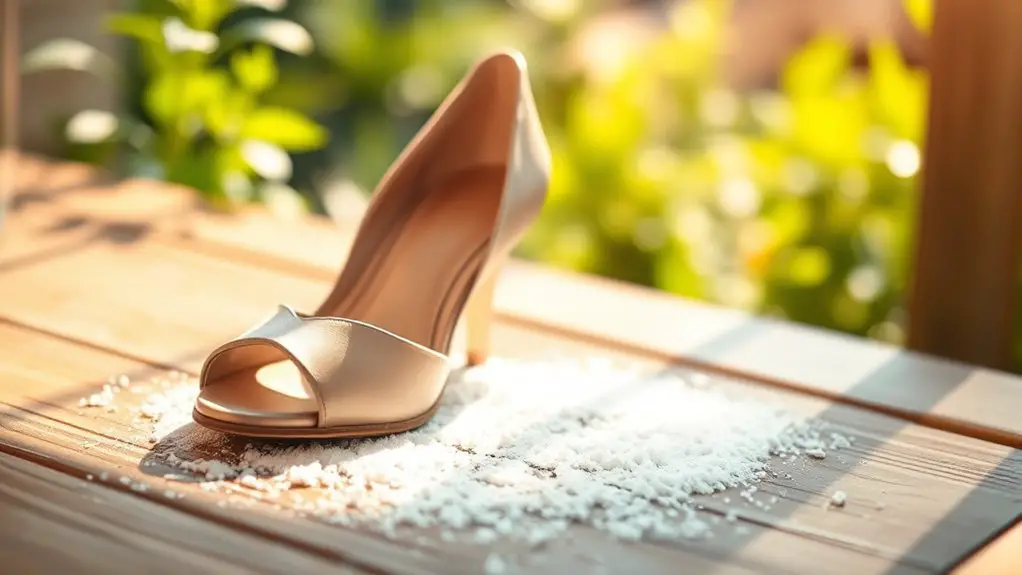
Using foot powder can greatly enhance dryness and comfort when wearing heels. There are various types of foot powders available, each designed to absorb moisture and reduce friction. Understanding the proper application techniques is essential for maximizing their effectiveness.
Types of Foot Powders
Foot powders are essential tools for combating moisture and odor, especially for those who frequently wear heels. Using the right type can greatly enhance your comfort during hot summer days. Here are some effective options:
- Talcum Powder: Absorbs moisture and reduces friction, making it ideal for keeping feet dry.
- Baking Soda: Neutralizes odors while absorbing sweat, providing a dual benefit.
- Cornstarch: A natural alternative that effectively absorbs moisture without harsh chemicals.
- Foot-Specific Powders: Formulated with antifungal properties to prevent athlete’s foot and other infections.
Choosing a suitable powder can make a considerable difference in your foot comfort. Remember to apply it generously in your shoes and on your feet for best results.
Application Techniques Explained
To maximize the effectiveness of foot powders, proper application techniques are essential. Start by ensuring your feet are clean and dry before applying the powder. Gently sprinkle a small amount onto your feet, focusing on the soles and between your toes, as these areas are prone to sweat. Use your hands to distribute the powder evenly. For best results, repeat this process before wearing heels, especially in hot weather.
| Application Step | Purpose | Tips |
|---|---|---|
| Clean and dry feet | Prepares for powder | Wash and dry thoroughly |
| Sprinkle powder | Creates a barrier | Use a light, even layer |
| Focus on key areas | Target sweat zones | Concentrate on soles/toes |
| Massage in | Enhances absorption | Use gentle circular motions |
| Reapply as needed | Maximize sweat prevention | Midday touch-ups if necessary |
Rotate Your Footwear
To effectively manage sweaty feet in heels, rotating your footwear is essential. Opt for shoes made from breathable materials and consider limiting heel height to promote better airflow and reduce moisture buildup. This simple practice can greatly enhance comfort and foot hygiene.
Choose Breathable Materials
Selecting breathable materials for your heels is essential in managing sweaty feet. When your footwear allows for proper heel ventilation, it can greatly reduce moisture accumulation. Opt for heels made from breathable fabrics that promote airflow, ensuring your feet stay dry and comfortable.
- Mesh: Provides excellent airflow and moisture-wicking properties.
- Leather: Natural leather can offer breathability while molding to your foot’s shape.
- Canvas: Lightweight and breathable, making it ideal for summer wear.
- Microfiber: Soft and breathable, it helps wick sweat away from the foot.
Limit Heel Height
While high heels can elevate your style, opting for lower heel heights can greatly reduce the likelihood of sweaty feet. Choosing heels under three inches enhances heel comfort, allowing for better weight distribution and less strain on your feet. This can lead to improved air circulation, which is vital during the summer months when foot perspiration often increases.
Additionally, rotating your footwear between different styles is important. By alternating between lower heels and more casual summer styles like flats or wedges, you give your feet a break and minimize moisture buildup. Prioritizing comfort in your footwear choices not only keeps your feet dry but also contributes to overall foot health. Making these adjustments can markedly improve your summer experience.
Keep Your Feet Clean and Dry
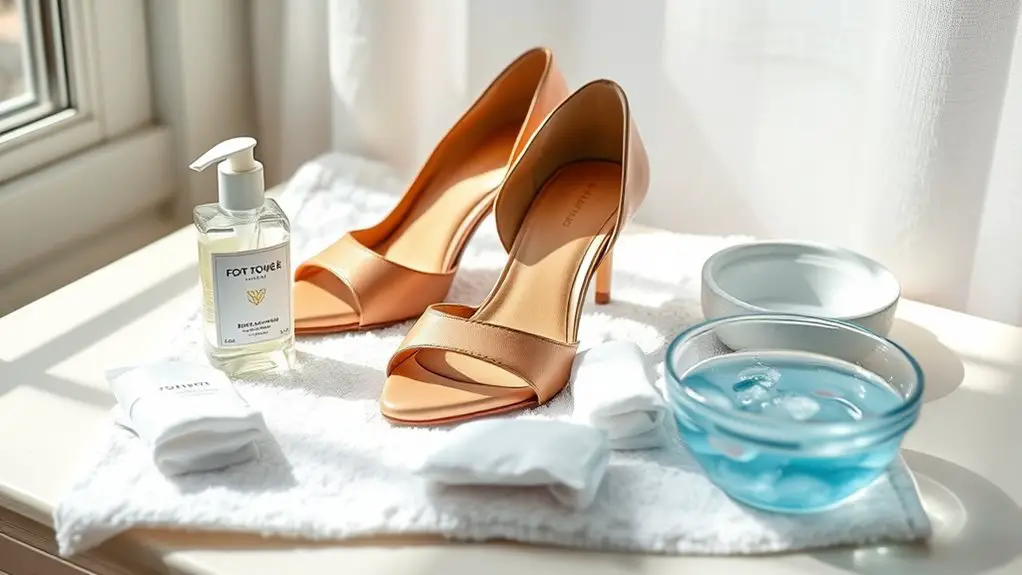
Maintaining clean and dry feet is essential for preventing sweat and odor, especially when wearing heels. Incorporating foot hygiene into your daily routine can make a significant difference in comfort and confidence.
- Wash your feet daily with soap and water, ensuring to clean between the toes.
- Dry your feet thoroughly, particularly in areas prone to moisture.
- Use foot powder to absorb excess sweat and keep your feet dry throughout the day.
- Change socks regularly, opting for moisture-wicking materials that promote breathability.
Consider Foot Antiperspirants
Even with good foot hygiene, some individuals may still struggle with sweaty feet, particularly when wearing heels. One effective solution is using foot antiperspirants. These products are specifically formulated to reduce moisture and odor, allowing you to wear your favorite heels without discomfort.
When considering foot antiperspirants, it’s essential to choose the right type and follow the recommended application frequency. Below is a comparison of common foot antiperspirant types:
| Type | Active Ingredients | Recommended Application Frequency |
|---|---|---|
| Roll-On | Aluminum Chloride | Daily before wearing shoes |
| Spray | Aluminum Zirconium | Daily or as needed |
| Cream | Talcum Powder | Every other day |
| Stick | Baking Soda | 2-3 times per week |
Frequently Asked Questions
Can I Wear Open-Toed Heels to Reduce Sweating?
Yes, you can wear open-toed heels to reduce sweating. Open toe options allow better airflow, making them a suitable choice for summer styles. However, consider materials and fit to maximize comfort and minimize heat retention.
What Are the Best Types of Breathable Materials?
Did you know that 70% of foot odor comes from moisture? To combat this, choose breathable fabrics like cotton or linen, and moisture-wicking materials such as polyester blends, which help keep your feet dry and comfortable.
How Often Should I Change My Socks During the Day?
You should change your socks at least once daily, or more frequently if they become damp. Opt for moisture-wicking sock materials; this enhances comfort and hygiene, minimizing the risk of foot issues associated with socks frequency.
Are There Specific Brands of Foot Powder Recommended for Heels?
You might think all foot powders are the same, but they’re not. Popular foot powder brands like Gold Bond and Dr. Scholl’s excel. Use proper application techniques for maximum effectiveness, ensuring your comfort throughout the day.
Should I Avoid Certain Heel Styles to Prevent Sweating?
Yes, you should consider heel height and style comfort. Certain styles, like narrow or high heels, can restrict airflow, increasing sweat. Opt for lower, wider heels for better ventilation and overall foot comfort during warmer months.

